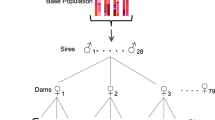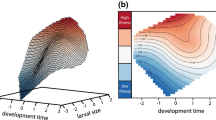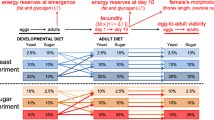Abstract
Much is known about the genetic variance in certain components of metabolism, most notably resting and maximum metabolic rate. This is in stark contrast to the lack of information on genetic variance in the metabolic rate of individuals that feed and express routine activity, and how this rate correlates with other components of the energy budget or life history traits. Here we quantify genetic variance in metabolic rate (MR) under such conditions, as well as food consumption, juvenile somatic growth rate and age at maturation under ad lib food availability in a set of 10 clones of Daphnia magna from a natural population. Broad sense evolvabilities (0.16–0.56%) were on the same order of magnitude as those typically observed for physiological and life history traits, and suggest that all these traits have the potential to evolve within this population. We did not find support for the previously hypothesized positive genetic correlation between metabolic rate and growth rate. Rather, the patterns of genetic correlations suggest that genetic variance in food consumption is the single most influential trait shaping somatic growth rate, but that additional variance in growth can be explained by considering the joint effect of consumption and MR. The genetic variance in consumption and MR also translated into genetic variance in age at maturation, creating a direct link between these energy budget components and a life history trait with strong fitness effects. Moreover, a weak positive correlation between MR and food consumption suggests the presence of substantial amounts of independent genetic control of these traits, consistent with results obtained using genomic approaches.




Similar content being viewed by others
References
Alvarez, D., & Nicieza, A. G. (2005). Is metabolic rate a reliable predictor of growth and survival of brown trout (Salmo trutta) in the wild? Canadian Journal of Fisheries and Aquatic Sciences, 62, 643–649.
Auer, S. K., Salin, K., Rudolf, A. M., Anderson, G. J., & Metcalfe, N. B. (2015). The optimal combination of standard metabolic rate and aerobic scope for somatic growth depends on food availability. Functional Ecology, 29, 479–486.
Bates, D., Mächler, M., Bolker, B., & Walker, S. (2015). Fitting linear mixed-effects models using lme4. Journal of Statistical Software, 67, 1–48.
Berteaux, D., Thomas, D. W., Bergeron, J. M., & Lapierre, H. (1996). Repeatability of daily field metabolic rate in female meadow voles (Microtus pennsylvanicus). Functional Ecology, 10, 751–759.
Biro, P. A., & Stamps, J. A. (2010). Do consistent individual differences in metabolic rate promote consistent individual differences in behavior? Trends in Ecology & Evolution, 25, 653–659.
Bordas, A., Tixierboichard, M., & Merat, P. (1992). Direct and correlated responses to divergent selection for residual food-intake in Rhode Island red laying hens. British Poultry Science, 33, 741–754.
Burton, T., Killen, S. S., Armstrong, J. D., & Metcalfe, N. B. (2011). What causes intraspecific variation in resting metabolic rate and what are its ecological consequences? Proceedings of the Royal Society B-Biological Sciences, 278:3465–3473.
Careau, V., Thomas, D., Humphries, M. M., & Reale, D. (2008). Energy metabolism and animal personality. Oikos, 117, 641–653.
Careau, V., Thomas, D., Pelletier, F., Turki, L., Landry, F., Garant, D., & Reale, D. (2011). Genetic correlation between resting metabolic rate and exploratory behaviour in deer mice (Peromyscus maniculatus). Journal of Evolutionary Biology, 24, 2153–2163.
Cheverud, J. M. (1988). A comparison of genetic and phenotypic correlations. Evolution, 42, 958–968.
Dohm, M. R., Hayes, J. P., & Garland, T. (2001). The quantitative genetics of maximal and basal rates of oxygen consumption in mice. Genetics, 159, 267–277.
Einum, S. (2014). Ecological modeling of metabolic rates predicts diverging optima across food abundances. American Naturalist, 183, 410–417.
Finstad, A. G., Naesje, T. F., & Forseth, T. (2004). Seasonal variation in the thermal performance of juvenile Atlantic salmon (Salmo salar). Freshwater Biology, 49, 1459–1467.
Fossen, E. I. F., Pelabon, C., & Einum, S. (2018). An empirical test for a zone of canalization in thermal reaction norms. Journal of Evolutionary Biology, 31, 936–943.
Fossen, E. I. F., Pelabon, C., & Einum, S. (2019). Genetic and environmental effects on the scaling of metabolic rate with body size. Journal of Experimental Biology (in press).
Fyhn, M., Gabrielsen, G. W., Nordoy, E. S., Moe, B., Langseth, I., & Bech, C. (2001). Individual variation in field metabolic rate of kittiwakes (Rissa tridactyla) during the chick-rearing period. Physiological and Biochemical Zoology, 74, 343–355.
Gebczynski, A. K., & Konarzewski, M. (2009). Locomotor activity of mice divergently selected for basal metabolic rate: a test of hypotheses on the evolution of endothermy. Journal of Evolutionary Biology, 22, 1212–1220.
Gillooly, J. F., Brown, J. H., West, G. B., Savage, V. M., & Charnov, E. L. (2001). Effects of size and temperature on metabolic rate. Science, 293, 2248–2251.
Glazier, D. S. (1991). Separating the respiration rates of embryos and brooding females of Daphnia magna: implications for the cost of brooding and the allometry of metabolic rate. Limnology and Oceanography, 36, 354–361.
Hansen, T. F., Pélabon, C., & Houle, D. (2011). Heritability is not evolvability. Evolutionary Biology, 38, 258–277.
Haupt, A., Thamer, C., Staiger, H., Tschritter, O., Kirchhoff, K., Machicao, F., Haring, H. U., Stefan, N., & Fritsche, A. (2009). Variation in the FTO gene influences food intake but not energy expenditure. Experimental and Clinical Endocrinology & Diabetes, 117, 194–197.
Houle, D. (1992). Comparing evolvability and variability of quantitative traits. Genetics, 130, 195–204.
Jobling, M. (1981). The influences of feeding on the metabolic rate of fishes—a short review. Journal of Fish Biology, 18, 385–400.
Jonsson, B., Forseth, T., Jensen, A. J., & Næsje, T. F. (2001). Thermal performance of juvenile Atlantic salmon, Salmo salar L. Functional Ecology, 15, 701–711.
Kluttgen, B., Dulmer, U., Engels, M., & Ratte, H. T. (1994). Adam, an artificial fresh-water for the culture of Zooplankton. Water Research, 28, 743–746.
Kooijman, S. A. L. M. (2010). Dynamic energy budget theory for metabolic organisation. Cambridge: Cambridge University Press.
Ksiazek, A., Konarzewski, M., & Lapo, I. B. (2004). Anatomic and energetic correlates of divergent selection for basal metabolic rate in laboratory mice. Physiological and Biochemical Zoology, 77, 890–899.
Marhold, S., & Nagel, A. (1995). The energetics of the common mole rat Cryptomys, a subterranean eusocial rodent from Zambia. Journal of Comparative Physiology B-Biochemical Systemic and Environmental Physiology, 164, 636–645.
McCarthy, I. D. (2000). Temporal repeatability of relative standard metabolic rate in juvenile Atlantic salmon and its relation to life history variation. Journal of Fish Biology, 57, 224–238.
Metcalfe, N. B. (1991). Competitive ability influences seaward migration age in Atlantic salmon. Canadian Journal of Zoology, 69, 815–817.
Metcalfe, N. B., Taylor, E. B., & Thorpe, J. E. (1995). Metabolic rate, social status and life-history strategies in Atlantic salmon. Animal Behaviour, 49, 431–436.
Metcalfe, N. B., Van Leeuwen, T. E., & Killen, S. S. (2016). Does individual variation in metabolic phenotype predict fish behaviour and performance? Journal of Fish Biology, 88, 298–321.
Millidine, K. J., Armstrong, J. D., & Metcalfe, N. B. (2006). Presence of shelter reduces maintenance metabolism of juvenile salmon. Functional Ecology, 20, 839–845.
Mrode, R. A., & Kennedy, B. W. (1993). Genetic variation in measures of food efficiency in pigs and their genetic relationships with growth rate and backfat. Animal Production, 56, 225–232.
Nespolo, R. F., & Franco, M. (2007). Whole-animal metabolic rate is a repeatable trait: a meta-analysis. Journal of Experimental Biology, 210, 3877–3878.
Nilsson, J. A., Akesson, M., & Nilsson, J. F. (2009). Heritability of resting metabolic rate in a wild population of blue tits. Journal of Evolutionary Biology, 22, 1867–1874.
Norin, T., & Clark, T. D. (2016). Measurement and relevance of maximum metabolic rate in fishes. Journal of Fish Biology, 88, 122–151.
Peck, M. A., & Moyano, M. (2016). Measuring respiration rates in marine fish larvae: challenges and advances. Journal of Fish Biology, 88, 173–205.
Poulsen, M., Bot, A. N. M., Nielsen, M. G., & Boomsma, J. J. (2002). Experimental evidence for the costs and hygienic significance of the antibiotic metapleural gland secretion in leaf-cutting ants. Behavioral Ecology and Sociobiology, 52, 151–157.
Present, T. M. C., & Conover, D. O. (1992). Physiological basis of latitudinal growth differences in Menidia menidia—variation in consumption or efficiency? Functional Ecology, 6, 23–31.
R Core Team 2014. R: a language and environment for statistical computing. Vienna: R Foundation for Statistical Computing.
Reid, D., Armstrong, J. D., & Metcalfe, N. B. (2012). The performance advantage of a high resting metabolic rate in juvenile salmon is habitat dependent. Journal of Animal Ecology, 81, 868–875.
Roff, D. A. (1995). The estimation of genetic correlations from phenotypic correlations—a test of cheveruds conjecture. Heredity, 74, 481–490.
Rønning, B., Jensen, H., Moe, B., & Bech, C. (2007). Basal metabolic rate: heritability and genetic correlations with morphological traits in the zebra finch. Journal of Evolutionary Biology, 20, 1815–1822.
Sadowska, E. T., Labocha, M. K., Baliga, K., Stanisz, A., Wroblewska, A. K., Jagusiak, W., & Koteja, P. (2005). Genetic correlations between basal and maximum metabolic rates in a wild rodent: Consequences for evolution of endothermy. Evolution, 59, 672–681.
Scantlebury, M., Waterman, J. M., Hillegass, M., Speakman, J. R., & Bennett, N. C. 2007. Energetic costs of parasitism in the Cape ground squirrel Xerus inauris. Proceedings of the Royal Society B-Biological Sciences, 274:2169–2177.
Sereni, L., & Einum, S. (2015). No evidence for activity adjustment in response to increased density in Daphnia magna. PLoS ONE, 10, e0144759.
Steyermark, A. C. (2002). A high standard metabolic rate constrains juvenile growth. Zoology, 105, 147–151.
Tillé, Y., & Matei, A. (2016). Sampling: Survey Sampling. R package version 2.8. https://CRAN.R-project.org/package=sampling. Accessed 26 Feb 2019.
Vezina, F., Speakman, J. R., & Williams, T. D. (2006). Individually variable energy management strategies in relation to energetic costs of egg production. Ecology, 87, 2447–2458.
Yamamoto, T., Ueda, H., & Higashi, S. (1998). Correlation among dominance status, metabolic rate and otolith size in masu salmon. Journal of Fish Biology, 52, 281–290.
Yashchenko, V., Fossen, E. I., Kielland, ØN., & Einum, S. (2016). Negative relationships between population density and metabolic rates are not general. Journal of Animal Ecology, 85, 1070–1077.
Zuur, A. F., Ieno, E. N., Walker, N. J., Saveliev, A. A., & Smith, G. M. (2009). Mixed effects models and extensions in ecology with R. New York: Springer.
Acknowledgements
We thank V. Yashchenko for help with culture maintenance, and two anonymous reviewers for helpful comments. Financial support was provided by the Research Council of Norway, FRIPRO programme, project ‘Eco-evolutionary dynamics of thermal reaction norms’ (Project 230482), and partly by the Research Council of Norway through its Centres of Excellence funding scheme, project number 223257/F50 and the Norwegian University of Science and Technology (NTNU).
Author information
Authors and Affiliations
Corresponding author
Ethics declarations
Conflict of interest
The authors declare that they have no conflict of interest.
Ethical approval
Animals were hatched from resting eggs, previously collected in the wild, and grown under healthy conditions in the laboratory. Laboratory conditions and procedures are not regulated by law for this particular crustacean species, as it is considered to be a less sentient animal.
Rights and permissions
About this article
Cite this article
Einum, S., Fossen, E.I.F., Parry, V. et al. Genetic Variation in Metabolic Rate and Correlations with Other Energy Budget Components and Life History in Daphnia magna. Evol Biol 46, 170–178 (2019). https://doi.org/10.1007/s11692-019-09473-x
Received:
Accepted:
Published:
Issue Date:
DOI: https://doi.org/10.1007/s11692-019-09473-x




